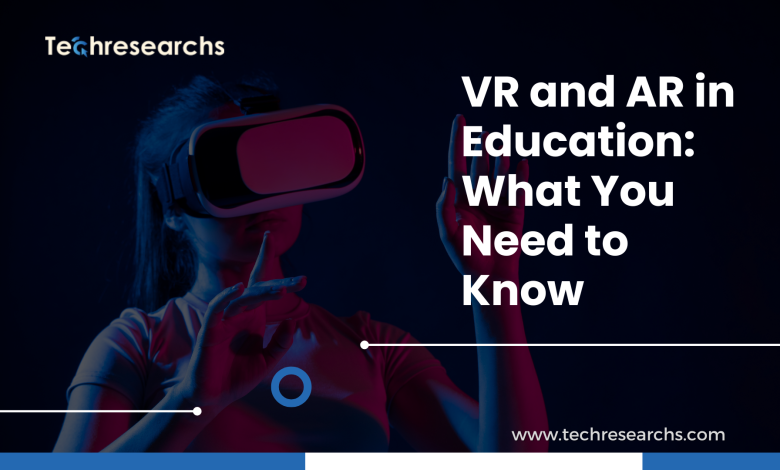VR and AR in Education: What You Need to Know

Virtual and augmented reality are dramatically changing the way we learn and teach. By integrating technology with traditional teaching methodologies, VR and AR enable the creation of immersive and interactive experiences for students of all ages. From making complicated science experiments accessible to organizing virtual field trips, these technologies transform education into an exciting and engaging journey.
In this article, we’ll explore how VR and AR are used in education, their benefits, challenges, and the future potential they hold for educators and students alike.
What Are VR and AR?
Before diving into their impact on education, it’s essential to understand the difference between VR and AR.
Virtual Reality (VR)
Virtual Reality (VR) creates an entirely immersive digital environment. Using VR headsets like Oculus or HTC Vive, users are transported into virtual worlds where they can interact with objects and scenarios.
Augmented Reality (AR)
Augmented Reality (AR) overlays digital information onto the real world through devices like smartphones, tablets, or AR glasses. For instance, apps like Pokémon Go allow virtual objects to appear in real-life surroundings.
Both technologies are finding their way into classrooms, transforming passive learning into active, in-the-moment experiences.
Advantages of VR and AR in Education
1. Increased Engagement
Traditional lectures often struggle to maintain students’ attention. VR and AR make learning an adventure:
- Students can virtually walk through ancient civilizations using VR.
- AR brings biology lessons to life by showcasing 3D models of the human body that students can manipulate in real-time.
2. Improved Knowledge Retention
Active learners tend to retain more information. VR and AR make abstract concepts tangible:
- Physics students can visualize forces at work through simulations rather than just reading about them.
3. Safe Learning Environment
VR provides a risk-free space for students to practice experiments or explore complex concepts:
- Chemistry students can simulate reactions without handling hazardous materials.
- Aspiring pilots can train in flight simulators, avoiding real-world risks.
4. Accessibility for All Students
VR and AR cater to diverse learners, including those with disabilities:
- AR apps offer visual aids for deaf students.
- VR simulations allow mobility-impaired students to experience activities like mountain climbing or underwater diving.
5. Global Collaboration
VR connects classrooms worldwide, fostering cultural exchanges and collaboration:
- Students from different countries can work together on projects in shared virtual spaces.
Challenges of Implementing VR and AR in Education
While the benefits are immense, there are several challenges to adopting these technologies.
1. High Costs
Setting up VR and AR hardware, devices, and software can be expensive. However, as the technology becomes more widespread, costs are expected to decrease.
2. Technical Limitations
Many institutions lack the infrastructure to support VR and AR integration:
- High-speed internet, advanced hardware, and trained staff are prerequisites.
3. Risk of Hyperdependency on Technology
While VR and AR are powerful tools, over-reliance on them might diminish critical thinking and interpersonal skills. These technologies should complement, not replace, traditional teaching methods.
4. Limited Content Availability
Currently, there’s a shortage of VR and AR content tailored to curricula. Developing such content can be time-intensive and costly.
Applications of VR and AR in Education
1. Medical Training
- Medical students can practice surgeries in a risk-free VR environment.
- AR apps provide detailed 3D models of human anatomy, enhancing understanding.
2. Virtual Field Trips
- Students can virtually explore the pyramids of Egypt or the Amazon rainforest through apps like Google Expeditions.
3. Language Learning
- AR apps like Mondly create immersive language-learning experiences, allowing students to practice conversations in real-time.
4. STEM Education
- AR projects 3D models of molecules in chemistry classes.
- VR lets engineering students simulate and test their designs in a virtual environment.
5. Special Education
- VR helps students with autism develop social and communication skills in controlled settings.
- AR offers interactive visual aids to support students with dyslexia.
The Future of VR and AR in Education
The potential for VR and AR in education is vast. Emerging technologies will likely drive significant advancements:
- Affordable Hardware: Costs will decrease, making the technology accessible to more schools.
- AI Integration: Artificial intelligence will enable personalized VR and AR experiences.
- Lifelong Learning: Adults will use these technologies for professional training and upskilling.
- 5G Technology: Faster internet speeds will reduce latency, providing seamless experiences.
How Schools Can Start Using VR and AR
1. Identify Needs
Determine where VR and AR can have the greatest impact on learning outcomes.
2. Start Small
Begin with affordable tools:
- Use free AR apps on tablets before investing in expensive VR headsets.
3. Train Teachers
Provide training for educators to ensure effective integration of VR and AR into their lesson plans.
4. Collaborate
Partner with technology providers and other schools to share resources and best practices.
Read more: Will AI Replace Programmers Sooner Than We Think? – TechResearchs
The dawn of VR and AR in education is transforming classrooms, offering engagement and immersion that traditional methods cannot match. While challenges like high costs and limited content persist, the benefits far outweigh the drawbacks. Schools and educators adopting these technologies today will lead the way in shaping the future of learning.
Are you ready to bring VR and AR into your educational institution? Explore these technologies now and revolutionize your classroom experience!